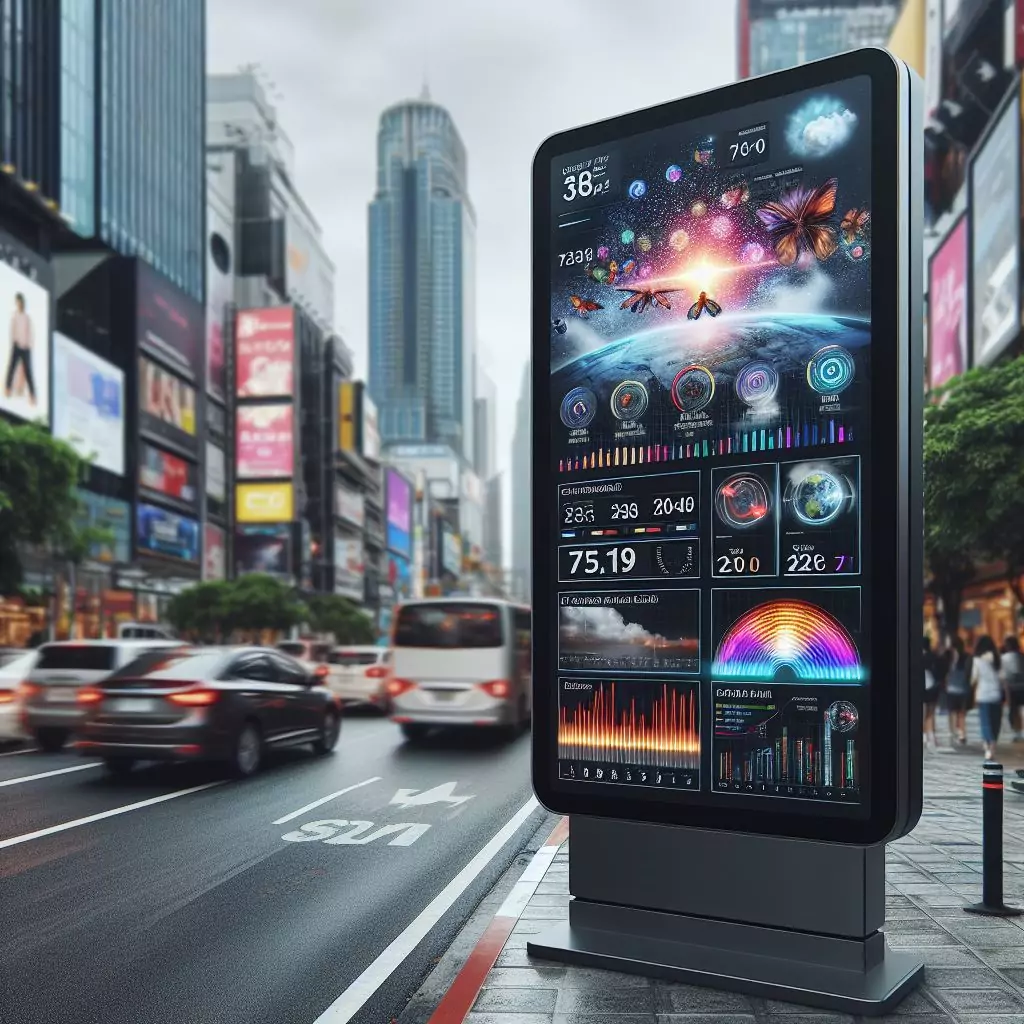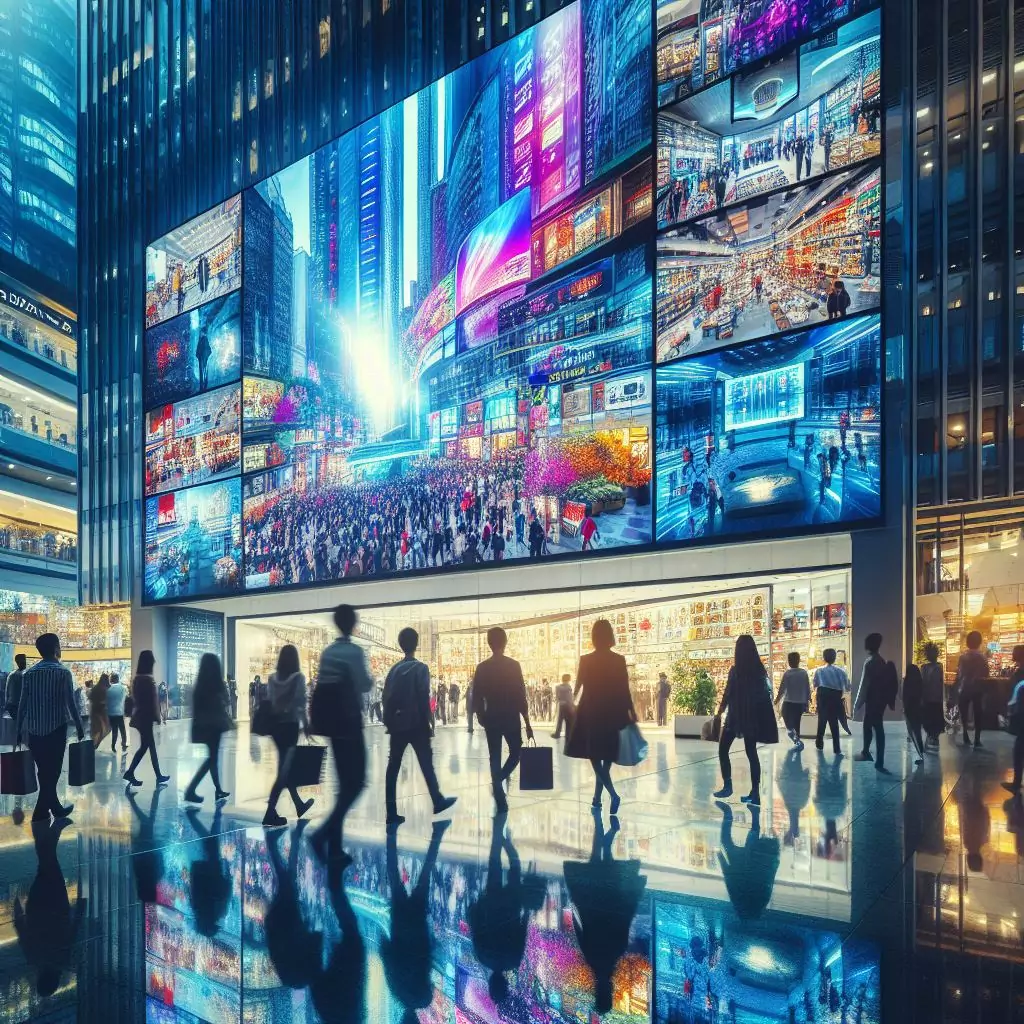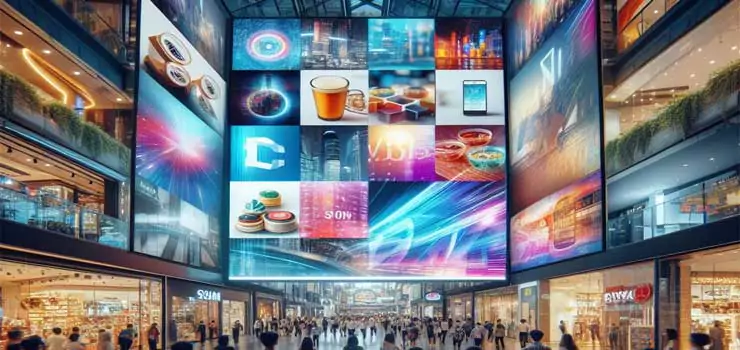Table of Contents
Introduction: Reimagine Your Marketing Landscape with Digital Signage
In today’s digital age, capturing attention and driving engagement is more crucial than ever. Traditional marketing methods are becoming increasingly ineffective as consumers are bombarded with advertising messages from all sides. To stand out from the noise, businesses need to adopt innovative and engaging strategies. This is where digital signage comes in.
What is Digital Signage?
Digital signage is the use of electronic displays to communicate with your audience. These displays can be used to showcase products and services, promote special offers, provide information, or simply entertain viewers. Unlike static signage, digital signage is dynamic and can be easily updated, making it a powerful tool for engaging your audience and driving results.
Static vs. Digital: Why Go Modern?
There are many reasons why businesses are making the switch from static to digital signage. Here are just a few:
- Increased engagement: Digital signage is more eye-catching and engaging than static signs. The use of video, animation, and interactivity can capture attention and hold viewers’ interest for longer.
- Improved brand awareness: Digital signage can help you build brand awareness by displaying your logo, messaging, and visuals dynamically and engagingly.
- Targeted messaging: Digital signage allows you to target your messaging to specific audiences. You can display different content based on the time of day, day of the week, or even the demographics of the viewers.
- Measurable results: With digital signage, you can track the effectiveness of your campaigns. You can see how many people are viewing your content, how long they are watching it, and what actions they are taking.
- Cost-effective: Digital signage can be a cost-effective way to reach a large audience. Once you have the initial investment in the hardware and software, the cost of creating and displaying content is relatively low.

The Power of Pixels: Unlocking Benefits You Never Knew Existed
Digital signage can have a profound impact on your business in a number of ways. Here are just a few of the benefits you can expect to see:
Boosting Sales:
- Impulse buys: Digital signage can trigger impulse purchases by showcasing products and services in a visually appealing way.
- Targeted offers: You can use digital signage to display targeted offers and promotions to specific customer segments.
- Upselling and cross-selling: Digital signage can be used to promote upsells and cross-sells by suggesting related products or services.
Enhancing Engagement:
- Captivate your audience: Digital signage can captivate your audience with visually stunning content, such as videos, animations, and interactive elements.
- Spark interaction: You can use digital signage to encourage interaction with your audience, such as through touchscreens, social media integration, or games.
- Build brand loyalty: By creating a positive and engaging experience for your customers, digital signage can help you build brand loyalty.
Streamlining Operations:
- Simplify content management: Digital signage software makes it easy to create, schedule, and update content from a central location.
- Reduce printing costs: Digital signage eliminates the need for printed materials, such as posters and brochures.
- Improve communication: Digital signage can be used to communicate important information to employees and customers, such as safety procedures or store hours.
Choosing the Right Display: Beyond the Tech Specs
When choosing a digital signage display, there are a few things to consider beyond the technical specifications. Here are some of the most important factors:
- Location: Where will the display be located? Consider factors such as ambient light, viewing distance, and weather conditions.
- Size: The size of the display should be appropriate for the location and the intended audience.
- Resolution: The resolution of the display should be high enough to provide clear and crisp images.
- Brightness: The brightness of the display should be sufficient to be seen in the ambient light conditions.
- Indoor vs. Outdoor: If the display will be used outdoors, you will need to choose a weatherproof display.
Less is More: Conciseness and Clarity for Optimal Message Delivery
The headline “Less is More: Conciseness and Clarity for Optimal Message Delivery” emphasizes the importance of simplicity and precision in crafting effective digital signage content. It breaks down into three key components:
- Less is More: This popular adage highlights the value of removing clutter and unnecessary elements. In the context of digital signage, it suggests that using fewer words, images, and animations can actually lead to a more impactful message.
- Conciseness: This refers to conveying your message in the fewest possible words or elements. Concise content is easier to understand and digest, maximizing the chance that viewers will retain the key takeaway.
- Clarity: This emphasizes the importance of using clear and unambiguous language and visuals. Avoid jargon, complex sentences, and confusing imagery to ensure that your message reaches its intended audience.
By combining these principles, you can create digital signage content that is visually appealing, easy to understand, and effectively communicates your desired message. Remember, viewers often have limited attention spans, so making your content concise and clear is crucial for capturing their interest and leaving a lasting impression.
Here are some additional points to consider:
- Focus on the “why”, not just the “what.”: Don’t just showcase your product; tell a story that resonates with your audience. Explain how your offering solves their problems or improves their lives.
- Utilize whitespace effectively: Don’t overload your visuals with information. Give your text and images room to breathe, making them easier to read and understand.
- Leverage animation and motion graphics sparingly: While animation can be impactful, use it strategically to highlight key points or add dynamism. Overuse can be distracting and counterproductive.
By following these guidelines and practicing conciseness and clarity, you can create digital signage content that truly connects with your audience and drives results.
Content is King: Crafting Captivating Visuals
- Less is More: Conciseness and Clarity for Optimal Message Delivery
While crafting beautiful visuals is essential, don’t forget the power of conciseness and clarity. Your audience is likely on the move, so ensure your message is easily digestible at a glance. Here are some tips:
- Use short, impactful copy: Aim for headlines that are clear and intriguing, with supporting text that’s concise and informative. Think of it like a newspaper headline – grab attention quickly and efficiently.
- Focus on the “why”, not just the “what.”: Don’t just showcase your product; tell a story that resonates with your audience. Explain how your offering solves their problems or improves their lives.
- Utilize whitespace effectively: Don’t clutter your visuals with too much information. Give your text and images room to breathe, making them easier to read and understand.
- Leverage animation and motion graphics sparingly: While animation can be impactful, use it strategically to highlight key points or add dynamism. Overuse can be distracting and counterproductive.
Design for Impact: Visuals That Stop Scrollers in Their Tracks
Beyond conciseness, consider these creative strategies to truly make your visuals stand out:
- Embrace bold colours and typography: Don’t be afraid to use vibrant colours and eye-catching fonts to grab attention. However, maintain legibility and ensure your chosen palette aligns with your brand identity.
- Play with scale and perspective: Experiment with different image sizes and layouts to create visual interest. Consider using unexpected cropping or angles to pique viewer curiosity.
- Incorporate multimedia elements: Combine text, images, and video to create rich and engaging experiences. Short, impactful video clips can be particularly effective in storytelling.
- Humor and surprise can go a long way: Don’t be afraid to inject a little humor or surprise into your visuals. This can make your content more memorable and leave a lasting impression.
- Remember storytelling: Use visuals to tell a story that connects with your audience on an emotional level. This will make your content more relatable and impactful.
By following these tips and letting your creativity flow, you can craft visuals that captivate your audience and drive results. Remember, the key is to find a balance between aesthetics, clarity, and engagement.
The Power of Video: Tell Compelling Stories and Showcase Products
While static visuals can be effective, video takes digital signage to a whole new level. Here’s why:
- Video captures attention: Moving images are inherently more engaging than static ones. They can quickly grab viewer attention and hold it for longer periods.
- Video tells stories: Video allows you to tell compelling stories that connect with your audience on an emotional level. This can be a powerful way to build brand awareness and loyalty.
- Video showcases products effectively: Video is a fantastic way to showcase your products and services in action. Show viewers how your offerings work and the benefits they provide.
- Video keeps information digestible: By combining visuals, audio, and text, video can present complex information in a way that is easy to understand and remember.
- Video offers versatility: There are endless possibilities for using video in digital signage. You can create product demos, customer testimonials, behind-the-scenes glimpses, or even short educational videos.
Also Read For Online MBA Degree Programs
Interactive Touches: Gamification and Personalization Keep Viewers Engaged
Digital signage isn’t just a one-way communication channel. It can be interactive, encouraging engagement and participation from your audience. Here are some ways to achieve this:
- Touchscreens: Incorporate touchscreens into your digital signage displays to allow viewers to interact with content. They can play games, answer polls, or access additional information.
- Social media integration: Encourage viewers to share your content on social media by displaying social media feeds or hashtags on your screens.
- QR codes: Use QR codes to link viewers to your website, landing pages, or other online content. This is a great way to provide more in-depth information or drive traffic to your website.
- Personalization: Use technology to personalize your content based on viewer demographics or past interactions. This can make your messaging more relevant and engaging.
Remember, the goal is to create an interactive experience that keeps viewers coming back for more.
Content Management Made Easy: From DIY to Cloud Solutions
Now that you’ve grasped the power of captivating content let’s explore how to manage it effectively. Digital signage software takes the hassle out of content creation, scheduling, and updates. Here’s a breakdown of your options:
Software to Your Rescue: Scheduling, Updating, and Analyzing with Ease
Digital signage software is your command center, allowing you to:
- Craft and edit eye-catching visuals: Most software comes with built-in design tools or integrates with popular design programs, making content creation a breeze.
- Schedule content playlists: Plan your content rollout, ensuring the right message hits the audience at the opportune time.
- Remotely update and manage: No need to be physically present to change content. Update your displays from anywhere with an internet connection.
- Track and analyze performance: Measure the effectiveness of your campaigns with built-in analytics tools. See what’s working and what’s not, and refine your strategy accordingly.
DIY or Done-for-You: Finding the Solution That Suits Your Needs
When it comes to digital signage software, you have two main choices:
- DIY Solutions: Perfect for small businesses or those with limited budgets, DIY software offers basic features at an affordable price. You’ll have more control over customization, but managing everything yourself can be time-consuming.
- Cloud-Based Solutions: A subscription-based model offering a wider range of features, including advanced scheduling, analytics, and remote management. Cloud-based software is ideal for larger businesses or those seeking a comprehensive solution.

Cloud Control: Remote Management for a Seamless Experience
Cloud-based digital signage software takes convenience to the next level. Imagine:
- Effortless updates: Make changes to your content from any device, anywhere in the world, with just an internet connection.
- Real-time monitoring: Keep an eye on your displays’ performance in real time, ensuring everything is running smoothly.
- Automatic updates: No more manually updating software or content. Cloud-based systems handle it automatically, keeping your signage fresh and secure.
- Scalability: Easily add or remove displays as your needs grow without worrying about software limitations.
Data-Driven Decisions: Using Analytics to Refine Your Strategy
Digital signage software provides valuable insights into how your audience interacts with your content. Track metrics like:
- Impressions: How many people are seeing your content?
- Engagement: How long are viewers spending looking at your displays?
- Click-through rates: If using interactive elements, track how many people are taking action.
By analyzing this data, you can learn what’s working and what’s not, allowing you to refine your content and strategy for maximum impact.
The Future of Digital Signage: Trends and Innovations to Watch
The digital signage landscape is constantly evolving, with new and exciting technologies emerging all the time. Here are a few trends to watch:
Beyond Screens: Augmented Reality and Immersive Experiences
Imagine your customers trying on clothes virtually or exploring your store layout through an AR app. Augmented reality (AR) overlays digital elements in the real world, creating immersive experiences that can revolutionize how we interact with brands.
Artificial Intelligence: Personalization and Dynamic Content on Autopilot
AI-powered digital signage can personalize content based on individual viewer demographics or preferences. Imagine a display that shows targeted ads or product recommendations to specific customers. AI can also automate content creation and scheduling, taking the workload off your shoulders.
Voice Activation and Interactivity: The Hands-Free Future of Engagement
Voice-activated digital signage allows viewers to interact with content using their voice. Imagine asking a display for product information or directions, all hands-free. This technology can make signage even more accessible and engaging.
Sustainability for the Win: Eco-Friendly Displays and Content Strategies
As environmental concerns grow, so does the demand for sustainable digital signage solutions. Look for energy-efficient displays and consider using recycled materials in your signage infrastructure. Additionally, create content that promotes sustainability to resonate with eco-conscious consumers.
FAQs
How much does digital signage cost?
The cost of digital signage can vary greatly depending on several factors, including display size and resolution, software, installation, and content creation.
- Displays: Basic setups with smaller screens and standard resolution can start around $500, while larger, high-resolution displays for outdoor use can reach several thousand dollars.
- Software: DIY software subscriptions start around $10 per month, while cloud-based solutions with advanced features can cost $50 or more per month per screen.
- Installation: Professional installation can range from a few hundred dollars to several thousand, depending on the complexity of your setup.
- Content creation: If you plan to outsource content creation, expect to pay hourly or project-based fees depending on the scope and complexity of your needs.
What content should I display?
The content you display should be relevant to your audience and align with your overall marketing goals. Some ideas include:
- Product promotions and special offers
- Company news and updates
- Customer testimonials and case studies
- Educational or informative content
- Interactive elements like games or polls
- Livestreams or social media feeds
Remember, keep your content concise, visually appealing, and focused on delivering value to your viewers.
How do I measure the success of my digital signage campaign?
Digital signage software provides valuable analytics tools to track the performance of your content. You can measure metrics like:
- Impressions: How many people are seeing your displays?
- Engagement: How long are viewers spending looking at your displays?
- Click-through rates: If using interactive elements, track how many people are taking action.
- Conversions: If linking to your website or social media, track how many people are taking the desired action after viewing your signage.
By analyzing these metrics, you can understand what’s working and what’s not, allowing you to adjust your content and strategy for optimal results.
Do I need technical expertise to manage digital signage?
Basic DIY software solutions are user-friendly and require minimal technical knowledge. However, if you opt for a complex setup with advanced features or plan to customize your content extensively, consider investing in training or hiring a professional to manage your digital signage system.
Where can I learn more about digital signage?
Several resources are available online and offline to help you learn more about digital signage, including:
- Industry publications and websites
- Trade shows and conferences
- Digital signage software providers
- Marketing and advertising agencies specializing in digital signage
Investing time in research and education will ensure you make informed decisions when implementing your digital signage campaign.
Remember, digital signage is a powerful tool that can transform your marketing efforts. By following the tips and insights in this guide, you can unleash its potential and achieve your business goals. So, take the plunge, embrace the future of marketing, and watch your business thrive!
Conclusion: Unleashing the Power of Digital Signage
Digital signage is a powerful tool that can transform the way you engage with your audience. By implementing the tips and insights in this guide, you can create captivating content, manage it effectively, and track your results to ensure success. So, embrace the future of marketing and unlock the power of digital signage to boost your sales, enhance engagement, and drive your business forward.




